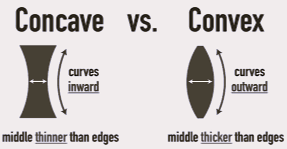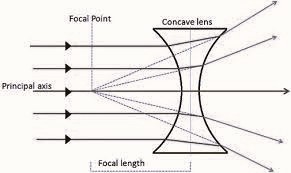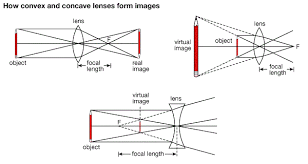Lenses are optical devices designed to manipulate light. In the realm of physics, lenses are crucial because they bend or refract light rays to either converge or diverge, which alters how we see objects. There are two main types of lenses- Convex and Concave, each with distinctive characteristics and uses.
Convex Lenses- Also known as converging lenses, Convex lenses are thicker at the centre and taper towards the edges. They bend light rays inward, causing them to meet or converge at a point known as the focal point. This characteristic makes Convex lenses useful in applications where magnification or focusing of light is needed.
Also Check – Convex Lenses- Principles, Applications, and Insights
Concave Lenses- In contrast, Concave lenses are thinner in the middle and thicker at the edges, resembling a cave-like shape. They spread light rays outward, making them diverge. These lenses are known as diverging lenses because they cause light rays to spread apart, which is useful in correcting certain types of vision problems like nearsightedness.
The fundamental differences between these two types of lenses, such as their shape, behaviour with light, and applications, is essential in the study of optics and various practical applications.
Table of Contents
Difference between Convex and Concave lenses in tabular format
| Aspect | Convex Lens | Concave Lens |
|---|---|---|
| Shape | Bulges outward, thicker at the centre, thinner towards the edges | Curves inward, thinner at the centre, thicker towards the edges |
| Type of Lens | Converging lens | Diverging lens |
| Focal Length | Positive | Negative |
| Ray Behavior | Converges light rays towards the focal point | Diverges light rays away from the lens |
| Image Formation | Can form real or virtual images; inverted or upright depending on object position | Always forms virtual, upright, and diminished images |
| Applications | Used in magnifying glasses, cameras, telescopes | Used in eyeglasses for correcting myopia, optical instruments |
Detailed Comparison of Convex and Concave Lenses
Difference between a Convex and Concave lens in terms of Shape-

- Convex Lens- A Convex lens bulges outward, resembling the exterior of a sphere. This lens is thicker at the centre and tapers off towards its edges. This shape is crucial for its ability to converge light rays.
- Concave Lens- In contrast, a Concave lens has an inward curve, similar to the inside of a sphere. It is thinner at the centre and becomes thicker towards the edges. This structure allows the lens to spread out or diverge light rays.
Difference between a Convex and Concave lens in terms of Type of Lens-

- Convex Lens- Classified as a converging lens, a Convex lens brings parallel light rays to a focus at a point known as the focal point.
- Concave Lens- Known as a diverging lens, a Concave lens causes parallel light rays to spread out or diverge as if they are emanating from a common point.
Difference between a Convex and Concave lens in terms of Focal Length-


- Convex Lens- The focal length of a Convex lens is positive, indicating that the focus is real and located on the same side of the lens as the light source after refraction.
- Concave Lens– The focal length of a Concave lens is negative, which means the focus is virtual and located on the opposite side of the lens from the light source.
Difference between a Convex and Concave lens in terms of Ray Behavior-

- Convex Lens- When light rays pass through a Convex lens, they converge or come together at a point. This is due to the lens’s shape bending the rays towards its central axis.
- Concave Lens- A Concave lens diverges light rays, causing them to spread apart. This divergence occurs because the lens bends the rays away from its central axis.
Difference between a Convex and Concave lens in terms of Image Formation-

- Convex Lens- Convex lenses can form both real and virtual images. Real images are formed when object distance is greater than the focal length, and these images are inverted. Virtual images are formed when the object is inside the focal length and is upright.
- Concave Lens- Concave lenses always form virtual, upright, and diminished (smaller than the object) images regardless of the object’s distance from the lens.
Difference between a Convex and Concave lens in terms of Applications-
- Convex Lens– Convex lenses are widely used in devices that require the convergence of light, such as magnifying glasses, cameras, and telescopes. They are essential for focusing and magnifying images.
- Concave Lens- The diverging property of Concave lenses makes them suitable for eyeglasses designed to correct myopia (nearsightedness). They are also used in certain optical instruments where controlled light divergence is necessary.
Curious Queries –Convex and Concave lenses
Can convex lenses create illusions?
Answer- Yes, convex lenses can magnify images, making objects appear larger or closer than they really are.
Why don’t concave lenses focus light to a point?
Answer- Concave lenses spread light rays out instead of bringing them together, so they don’t focus light to a point but rather diverge it.
Could we use convex lenses to generate solar power?
Answer- Convex lenses can concentrate sunlight onto a small area, potentially useful in solar power applications to generate heat.
Can concave lenses be used in telescopes like convex lenses?
Answer- Concave lenses are generally not used for the main lens in telescopes because they disperse light. However, they can be used in other parts of telescopes for specific purposes.
What happens if you use a convex lens underwater?
Answer- Underwater, the focusing ability of a convex lens changes due to the different light refraction properties of water compared to air.
Why are convex lenses used in eyeglasses for far-sighted people?
Answer- Convex lenses correct far-sightedness by focusing light onto the retina, helping people see distant objects more clearly.
Can a concave lens ever form a real image?
Answer- Generally, concave lenses form virtual images because they diverge light rays. However, under certain conditions with additional lenses, they can contribute to forming a real image.
If you combine a convex and concave lens, what happens?
Answer- Combining them can either enhance or cancel out their effects, depending on their arrangement and focal lengths. This is used in complex optical systems.
Frequently Asked Questions
What is the main difference between convex and concave lenses?
Answer– Convex lenses converge (bring together) light rays, forming a real image. Concave lenses diverge (spread out) light rays, usually forming a virtual image.
Where are convex lenses commonly used?
Answer- Convex lenses are used in magnifying glasses, cameras, and eyeglasses for far-sightedness.
Can concave lenses magnify objects?
Answer- No, concave lenses create smaller or virtual images, so they don’t magnify objects like convex lenses do.
Why do concave lenses make things look smaller?
Answer- They spread out light rays, which makes the images appear smaller than they are.
How do convex and concave lenses affect light differently?
Answer- Convex lenses focus light to a point, making images clearer or larger, while concave lenses spread light out, making images appear smaller or distorted.
Are concave lenses used in glasses for nearsightedness?
Answer- Yes, concave lenses correct nearsightedness by diverging light rays, which helps focus the image on the retina.
Also Check – Concave Lenses- Applications, Image Formation, and Principles
Also Check – Convex Lens Ray Diagrams and Image Formation
Also Check – Difference Between a Convex and Concave Lens
Also Check – Refraction of Light- A Comprehensive Guide for Students
Also Check – What is Light Reflection? A Simple Guide to Understanding Reflections
Also Check – Laws of Refraction- A High School Student’s Comprehensive Guide
